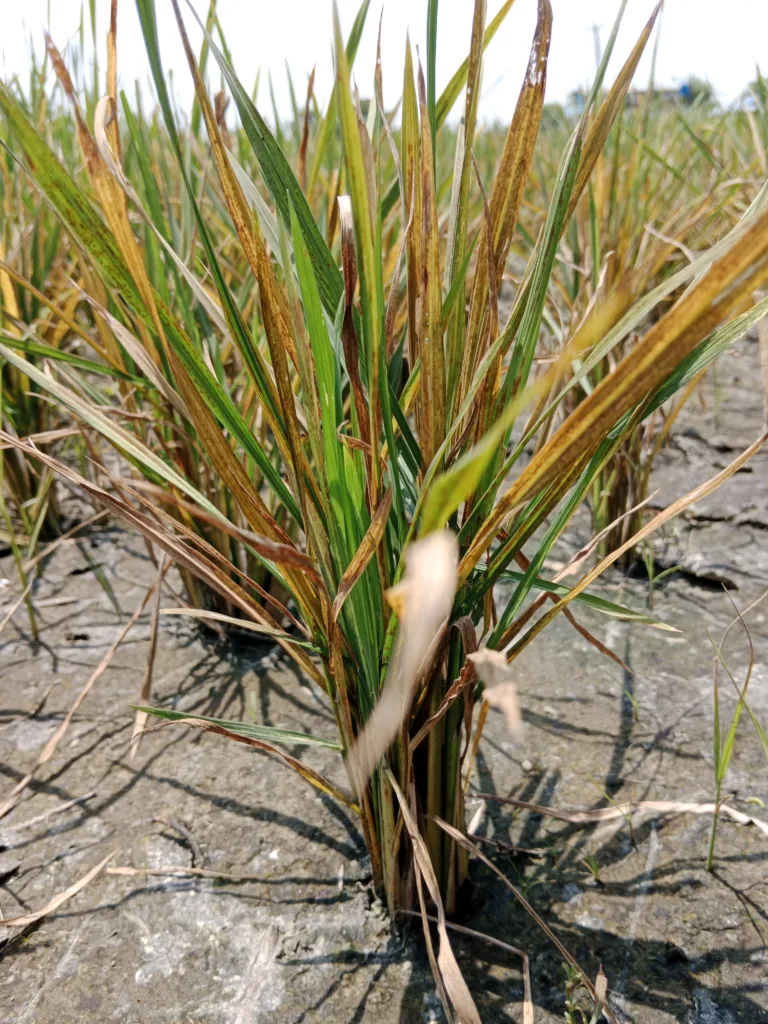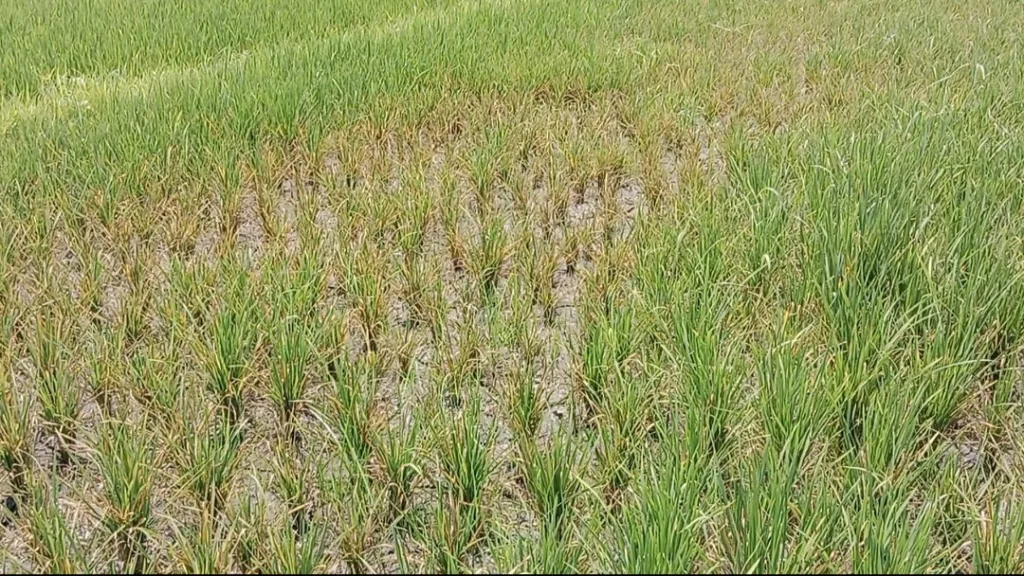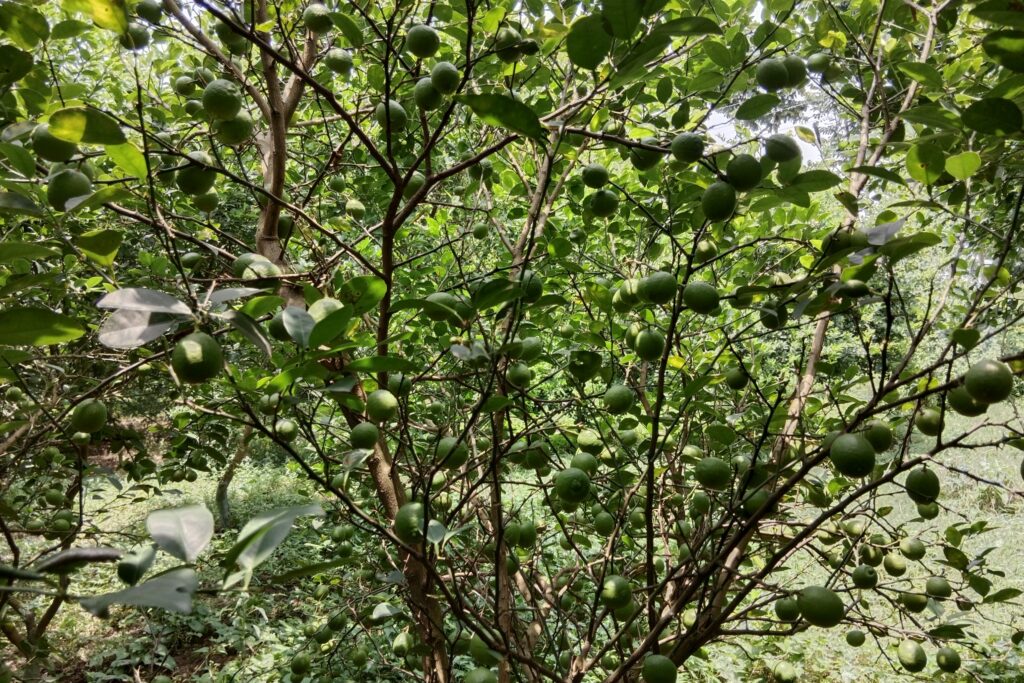What is Zinc Deficiency?
The most lacking micronutrient in soils globally is zinc. According to research, 49% of the world’s agriculturally significant soils have insufficient zinc levels, which causes a third of the world’s population to suffer from zinc insufficiency (Sillanpää, 1990; Cakmak et al., 2010). This shortage affects millions of hectares of agriculture, majorly affecting human health and agricultural output.

Zinc (Zn) deficiency is the most prevalent micronutrient disorder affecting rice. In fields with zinc deficiency, grain yield can be reduced by as much as 80%.
Zinc is only slightly mobile in plants and quite immobile in soil. In Asia, zinc deficiency has been identified as a widespread issue in lowland rice areas. Zinc deficiency is currently regarded as one of the most common nutritional diseases in lowland rice agriculture, along with nitrogen (N) and phosphorus (P) deficits. Soil zinc application can increase the zinc concentration in rice grains by 7%, while foliar application can result in a 25% increase. However, high soil pH in calcareous soils often exacerbates zinc deficiency.
The presence of certain metal cations, such as Cu²+ and Fe²+, inhibits zinc uptake by plants, as they compete for the same transport mechanisms to enter plant roots. This challenge is particularly pronounced in rice, which is highly sensitive to zinc deficiency. Flooding further reduces zinc availability, exacerbating the problem in rice-producing areas. Low zinc levels in soil can also result from intense leaching in highly acidic soils.
Zinc is crucial for normal human growth and development, and its widespread deficiency has been reported in many rice-producing regions. Studies suggest applying zinc to crops like rice could effectively address human zinc deficiency. Research has shown that foliar fertilization is a more effective method for correcting zinc deficiency in rice compared to base fertilization. Zinc deficiency in rice not only reduces pollen viability but also leads to reduced grain set and severe yield penalties.
It is found in research that soil application of zinc has been shown to increase the zinc concentration in rice grains by 7%, whereas foliar application can achieve a 25% increase. Moreover, incorporating zinc into staple foods like rice could help reduce zinc deficiency in both humans and animals. This approach offers a promising solution to address the widespread issue of zinc deficiency and improve overall health outcomes.
Importance of Zinc in Rice Field
Plant growth is restricted by low zinc levels in the soil or by unfavorable soil conditions that prevent plants from absorbing zinc. One example of these situations is continuous flooding which hinders the uptake of plants. In these situations, zinc should be applied as needed. For a healthy and productive crop, it’s also necessary to apply other minerals in proportionate proportions and guarantee a positive reaction to zinc fertilization.
Causes of Zinc Deficiency
Zinc (Zn) deficiency in soil is linked to various conditions, including high pH levels (>7.0), low available zinc content, prolonged submergence with low redox potential, high organic matter and bicarbonate content, an elevated magnesium (Mg) to calcium (Ca) ratio, and high available phosphorus (P). High soil pH, particularly in calcareous soils, is a primary factor contributing to widespread zinc deficiency.

In calcareous soils, high pH appears to be the main cause of zinc deficiency. Additionally, other soil conditions such as high calcite content, high bicarbonate ion concentration, and elevated levels of available phosphorus exacerbate the problem. The perennial wetness in some regions is another significant cause of zinc deficiency, particularly in continuously flooded paddy fields.
The main soil factors that affect zinc availability to plants include low total zinc content, high pH, and high levels of calcite and organic matter. Soils with high concentrations of sodium (Na), calcium (Ca), magnesium (Mg), bicarbonate, and phosphate in the soil solution or in labile forms also contribute to the issue. These conditions hinder the uptake of zinc by plants, leading to deficiency.
Improper fertilization practices can further aggravate zinc deficiency. For instance, excessive application of phosphorus fertilizers can increase the availability of phosphorus in the soil, which competes with zinc uptake by plants. This imbalance can exacerbate zinc deficiency, particularly in soils already prone to this issue.
Zinc deficiency is not very common but can occur in several specific soil types and conditions. These include neutral and calcareous soils, intensively cropped soils, continuously flooded paddy soils, very poorly drained soils, sodic and saline soils, peat soils, soils with high available phosphorus and silicon status, sandy soils, highly weathered acid and coarse-textured soils, soils derived from serpentine and laterite, and leached old acid sulfate soils with low concentrations of potassium (K), magnesium (Mg), and calcium (Ca).
Understanding the soil conditions that lead to zinc deficiency is crucial for implementing effective soil management and fertilization practices. Addressing these issues can significantly improve zinc availability and uptake, thereby enhancing crop yield and quality.
Symptoms of Zinc Deficiency or Khaira Disease in Rice
- Zinc deficiency symptoms appear 2 to 3 weeks after transplanting rice seedlings.
- Leaves develop brown blotches and streaks, which can entirely cover older leaves.
- Affected plants remain stunted and may die in severe cases; survivors exhibit delayed maturity and reduced yields.
- Dark brown to reddish spots appear on young, slightly chlorotic leaves.
- Older leaves acquire a bronze tint starting from the leaf margin, while the midrib stays green for an extended period.
- Prolonged deficiency turns the entire leaf blade bronze to brown.
- Symptoms include stunted growth, dusty brown spots on upper leaves, and patches of poorly established plants.
- There is increased spikelet sterility and a higher proportion of empty grains.
- Chlorotic midribs, particularly near the leaf base of younger leaves, are common.
- Reduced tillering occurs, potentially ceasing altogether in severe cases.
- Delayed maturity and decreased yields are typical outcomes.
- Leaf blades become smaller in size.
- Symptoms are like sulfur (S) and iron (Fe) deficiencies in alkaline soils and iron toxicity in poorly drained organic soils.
Role of Zinc in Rice Plant
Zinc is an essential nutrient for rice plants, crucial for several biochemical processes such as chlorophyll production and maintaining membrane integrity. Consequently, zinc deficiencies impact plant color and turgor. Zinc is only slightly mobile within the plant and is quite immobile in the soil.
What are the sources of Zinc?
Commonly used zinc fertilizers include soluble zinc sulfate (23−36% Zn), soluble zinc chloride (48−50% Zn), and insoluble zinc oxide (60−80% Zn).
Management of Zinc deficiency or khaira disease in rice.
Apply zinc fertilizer to the soil surface after the last puddling and leveling in the main field, or to the nursery beds 7-8 days before pulling seedlings. The effect of zinc application can last for 2-5 crop seasons on most soils, but in alkaline soils, zinc may need to be applied to each crop.
Preventing zinc deficiency is a critical aspect of overall crop management. To address zinc deficiency in rice crops, follow these guidelines:
Here are some measures to prevent zinc deficiencies:
- Grow cultivars that are efficient in zinc uptake. For the latest list of available types, contact your local agriculture office.
- Use fertilizers that create acidity, such as ammonium sulfate, instead of urea.
- Apply organic manure to the nursery seedbed a few days before transplantation or before sowing or transplanting.
- For fields planted with three crops annually and continually inundated, allow them to dry up and drain regularly.
- Monitor the quality of the irrigation water.
- Evenly apply zinc sulfate (ZnSO4) across the nursery seedbed.
- Soak seeds or seedlings in a 2-4% ZnO suspension (20-40 g ZnO per liter of water) before planting.
- Apply 25 kg of ZnSO4 per hectare.
- Use a foliar spray containing a 0.5% ZnSO4 solution (5 g/liter) twice at intervals of 15 days.
FAQs
Q1. How to treat zinc deficiency in plants?
The first step in correcting a zinc deficit in plants is to apply zinc fertilizers, such as zinc sulfate or zinc chelates, to the soil. Foliar sprays containing zinc solutions can be applied directly to plant leaves to provide immediate advantages. Particularly in alkaline soils, soil pH can be gradually lowered to enhance zinc availability. Composting and other organic waste can also increase zinc uptake by improving soil structure and microbial activity. It is advisable to conduct routine soil testing to ensure balanced fertilization methods, which include utilizing other nutrients appropriately to avoid competing inhibition of zinc uptake and to track zinc levels.
Q2. Which zinc is best for paddy?
For paddy cultivation, zinc sulfate is considered the best zinc fertilizer due to its high solubility and effectiveness. Zinc sulfate, typically available in monohydrate (36% Zn) or heptahydrate (23% Zn) forms, quickly dissolve in water, making zinc readily available to rice plants. It can be applied directly to the soil or used as a foliar spray for more immediate results. Foliar applications of zinc sulfate are particularly effective in addressing acute zinc deficiencies, leading to rapid uptake and improvement in plant health. Additionally, zinc sulfate is cost-effective and widely available, making it a popular choice among farmers.
Q3. What is the disease of zinc deficiency in rice?
A zinc deficiency in rice leads to khaira disease, which causes stunted plant growth, leaf discoloration, decreased tiller, and the development of sterile grains. Deficits in zinc are typically found in low-lying areas with high pH values.


